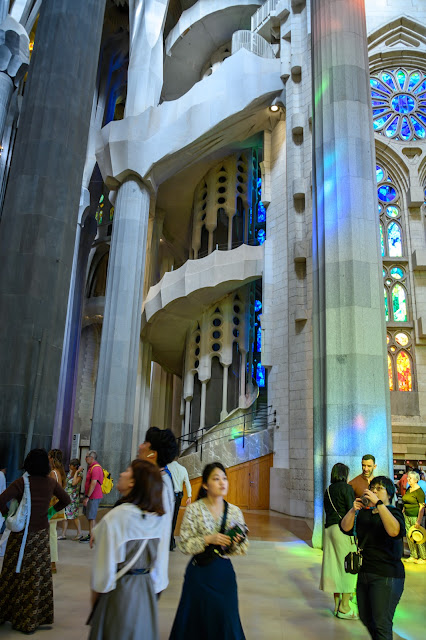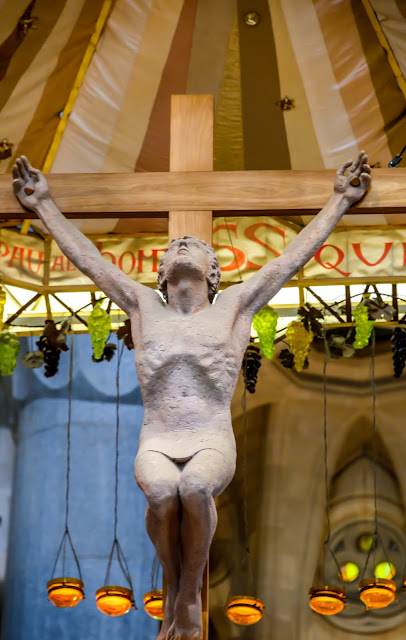Getting around this city is one of the simplese things to do. The buses and metro are so easy to figure out and they run constantly.
In order to go to one of the biggest and one of the most awe inspiring structures in this country we chose the metro.
Ten minutes later we were in 'Eixample Barrio'. Eixample, which translates as "extension" in recognition of its status as the newer part of the city has several highlights of which three belong to Gaudi.
Before sharing those highlights let me present some information about Gaudi.
Antoni Gaudí, (born June 25, 1852, died June 10, 1926, Barcelona) was a Catalan architect, whose distinctive style is characterized by freedom of form, voluptuous colour and texture, and organic unity. Gaudí worked almost entirely in or near Barcelona all his life. He was the son of a coppersmith who showed great interest in architecture early in life. Guadi's style of architecture went through several phases. At the begining of his career he practiced a rather florid Victorianism which came about from his schooling days. But he quickly developed a manner of composing by means of unprecedented juxtapositions of geometric masses, the surfaces of which were highly animated with patterned brick or stone, gay ceramic tiles, and floral or reptilian metalwork. The general effect, although not the details, being Moorish or Mudéjar, as Spain’s special mixture of Muslim and Christian design is called.

Gaudi, then went onto experimenting with Gothic and Baroque styles. Eventually, being somewhat of an eccentric, as well as a major participant in the Renaixensa (Catalan Renaissance) and his passione for nature and religion. Gaudi's style of architecture became know as Catalan Modernism. But his works go beyond any one style or classification.
Gaudí was involved in the construction phase of a total of 17 buildings during his lifetime and was involved in the design of three buildings that were not, or at least not fully, realised during the architect's life.
Sagrada Familia being one of the three.
On March 19th, 1882 construction of the Sagrada Família began under architect Francisco de Paula del Villar. In 1883, when Villar resigned, Gaudí took over as chief architect, transforming the project with his architectural and engineering style, combining Gothic and curvilinear Art Nouveau forms. Gaudí devoted the remainder of his life to the project, and he is buried in the church's crypt. At the time of his death in 1926, less than a quarter of the project was complete.
The Sagrada Família was inspired by a bookseller, José María Bocabella, after a visit to the Vatican in 1872. Bocabella returned from Italy with the intention of building a church inspired by the basilica at Loreto. The apse crypt of the church, funded by donations, was begun March 19th, 1882 to the design of the architect Francisco de Paula del Villar, whose plan was for a Gothic revival church of a standard form. The apse crypt was completed before Villar's resignation on March 18th, 1883, when Antoni Gaudí assumed responsibility for its design, which he changed radically.
When Gaudí died in 1926, the basilica was between 15 through 25 percent complete. After Gaudí's death, work continued under the direction of his main disciple Domènec Sugrañes i Gras until interrupted by the Spanish Civil War in 1936. Parts of the unfinished basilica and Gaudí's models and workshop were destroyed during the war. The present design is based on reconstructed versions of the plans that were burned in a fire as well as on modern adaptations. Since 1940, the architects Francesc Quintana, Isidre Puig Boada, Lluís Bonet i Garí and Francesc Cardoner have carried on the work.
As of 2006, work concentrated on the crossing and supporting structure for the main steeple of Jesus Christ as well as the southern enclosure of the central nave, which will become the Glory façade. Computer-aided design technology has allowed stone to be shaped off-site by a CNC milling machine, whereas in the 20th century the stone was carved by hand.
In 2008, some renowned Catalan architects advocated halting construction to respect Gaudí's original designs, which, although they were not exhaustive and were partially destroyed, have been partially reconstructed in recent years.
The church was consecrated by Pope Benedict XVI on November 7th, 2010 in front of a congregation of 6,500 people. A further 50,000 people followed the consecration Mass from outside the basilica, where more than 100 bishops and 300 priests were on hand to distribute Holy Communion.
In 2012, Barcelona-born Jordi Faulí i Ollertook over as architect of the project. Mark Burry of New Zealand serves as Executive Architect and Researcher. Sculptures by J. Busquets, Etsuro Sotoo and the controversial Josep Maria Subirachs decorate the fantastical façades.
In October 2015, architect Jordi Faulí announced that construction was 70 percent complete and had entered its final phase of raising six immense steeples. The steeples and most of the church's structure were planned to be completed by 2026, the centennial of Gaudí's death; as of a 2017 estimate, decorative elements should be complete by 2030 or 2032.
No photo nor video of this immense structure, can ever describe the beauty, awe inspirng, jaw dropping, hair raising, feeling one experinces when seeing this basilica in person. This is one construction that one has to see in person to truly appreciate its aesthetics.
(source)



































































































0 comments:
Post a Comment